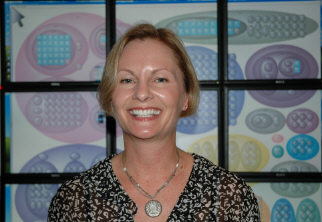A large screen is in your future

Despite the fact that smaller, handheld screens are outnumbering desktops, Microsoft Research has a thing for big screens. I visited the Redmond research offices and almost every office had two or three screens lined up side by side. The demo rooms have walls full of interlocking screens. It’s apparent that larger screens—20 to 30 inches, as well as multiple screen configurations--will become more mainstream over the next few years, and Microsoft is trying to figure out the best way to design software that takes advantage of the increased screen real estate. An enthusiastic Mary Czerwinski, senior researcher and manager of the Visualization and Interaction for Business and Entertainment (VIBE) Group, showed me some of the work in progress.

Mary Czerwinski, senior research and VIBE group manager
Czerwinski’s group did a survey and found that 22 percent of projected Longhorn users used a laptop and an additional display or were running two monitors or more on one PC. Her group has developed software, such as large cursor for wall-sized screens and techniques for mousing more effectively across screens. For example, Mouse Ether eliminates warping effects in moving a mouse cursor across multiple screens, which may have different resolutions and offsets. A high-density cursor eliminates the lost or blurred cursor phenomenon when moving across multiple screens by filling the space between the current cursor position and the previous one with additional cursor images.
In addition to navigating large screen spaces, Czerwinski's team is also working on visual representation of information. The Memex project explores the capture and presentation of a lifetime of digital information, as part of the My LifeBits Project. On large screens, data can be displayed in a variety of ways based on filtering criteria and visualization types, such as timelines, clusters and pages.
Large screen data visualization for the Memex project
Another aspect of working with large screens is locating key information, such as the Start menu and notification, where the user's attention is on the screen to avoid mousing across long distances to take an action. In addition, with the possibility to have many windows and applications open on a large screen, Czerwinski's group is looking at ways to group open tasks that aren't active on the periphery of a large display or set of screens, so users can focus on their current task more easily.
Touchlight inventor Andy Wilson in his lair
Beyond the mouse for navigation of large surfaces is the world of gestures. Microsoft researcher Andy Wilson has developed TouchLight, which uses a semi-transparent panel with two video cameras behind it to make large surfaces, such as tabletops, usable for display and interaction. With the movement of a hand, a user can move object around on the screen. It's not exactly the gesture interaction seen the film "Minority Report," but moving in that direction.
Today, we are still using the same metaphors and techniques that existed nearly 30 years ago--we are just doing it better. The transition to gesture, speech and displays, with optimized software, ranging from wall-sized to wrist watch will take many more years to become mainstream, but you can see that it's just not science fiction any more...